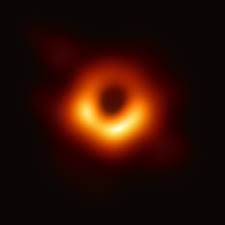Welcome!
Welcome to my blog!
Over the coming weeks, I’ll be using this blog to walk through my senior project about black holes and photon rings step-by-step. (The blog is also available at its original home here, but the blog on this site has the math formatted a little more nicely.) The first posts will be background posts, dedicated to understanding the basics of general relativity and black holes, so that everyone reading has a clear starting point for what exactly we’re studying, and a basic framework for how strange, exotic objects like black holes behave and why they behave the way they do. After this, I’ll move on to the current literature about the particular problem I’m interested in (more on that below), and the current gaps in said literature. Lastly, I’ll get to my own contributions to the topic and why I think they’re significant, as well as why I think studying black holes so closely, despite already being very well-studied objects, is such a promising avenue in contemporary physics.
Don’t worry if you don’t understand everything I’ll be elaborating on below yet; my goal here is just to give you a teaser of what my project hopes to accomplish and what this blog will cover in the future—once you read my background and literature review posts, hopefully the things said here that might have confused you will make a lot more sense. Additionally, as a general disclaimer, some of the later posts might be somewhat math-heavy, but don’t be too alarmed: I’ll do my best to make everything completely comprehensible if you skip over all the math, although trying to think through the math would certainly be useful for those who are interested.
Essentially, my project deals with what data can potentially be inferred from black hole images. Black holes images are a very delicate business: for one, black holes are, as the name suggests, black. This means that no light escapes them, making them technically impossible to image. This is where the photon rings come into the picture: although black holes themselves are completely un-imageable, since any photons within the black hole’s radius of innermost stable circular orbit never escape it, photons slightly outside the horizon (“nearly bound” photons, as they are often known) do escape, and are seen in images as rings around the black holes.

You can see above the most iconic black hole image (and one of the few ever taken): the black hole M87* as imaged by the EHT (Event Horizon Telescope), and in this photo you can see the photon rings I’ve referred to, albeit with somewhat low resolution. Because black holes are theoretically very well-studied objects, and the behavior of spacetime around black holes (at least outside their event horizon) has a significant corpus of literature, we can use the equations of motion for photons around black holes to predict what an image of the photon rings around a black hole with certain properties—and conversely we can try to deduce said properties given an image of a photon ring, although this problem is significantly more difficult. My project is (mostly) concerned with the former problem: what should the image of a black hole (or technically, its photon rings) look like given its properties? What characteristic features or structures emerge from the photon rings as a result of these properties, and how, mathematically, do these features depend on said properties?
Most importantly—why does any of this matter? What does studying the behavior of photons around black holes light-years away from us even help us understand? This is a question that I will come back to later in the blog, but the short answer has to do with the extreme environments created around black holes that are found in very few other places in nature. The laws of physics are currently very well understood for very nearly any physical system imaginable; general relativity describes even the most massive objects, for example, and quantum mechanics even the smallest. But thes models tend to break down at the union of these two situations: the physics of very small regions of space with very high densities of mass or energy is one of the most gaping holes in our understanding of physics, in part because there are very few sources of experimental data for physical systems of this kind. The behavior of high-energy particles or the extreme conditions of the Big Bang have historically been where physicists have searched for answers to these questions, but many, many questions remain unanswered even after pursuing these avenues. I believe that with the advent of black hole imaging, an entirely novel route has opened up to study the physics of the extreme, and there is great potential over the coming years to use black holes, previously extensively studied theoretically but never observed, as a probe of the geometry of more general physical theories.
My hope is that while reading through this blog you gain some insight not only into my project, but also into the physics underpinning it and the frontiers of our current understanding. As I explained above, future posts will start quite general, with general relativity (hah?), before delving into the more specific nuances of black hole imaging, and possibly (time permitting) how the analytical techniques I’ve used here could be generalized to theories beyond GR.
Thanks for reading, and stay tuned!
Sidhant